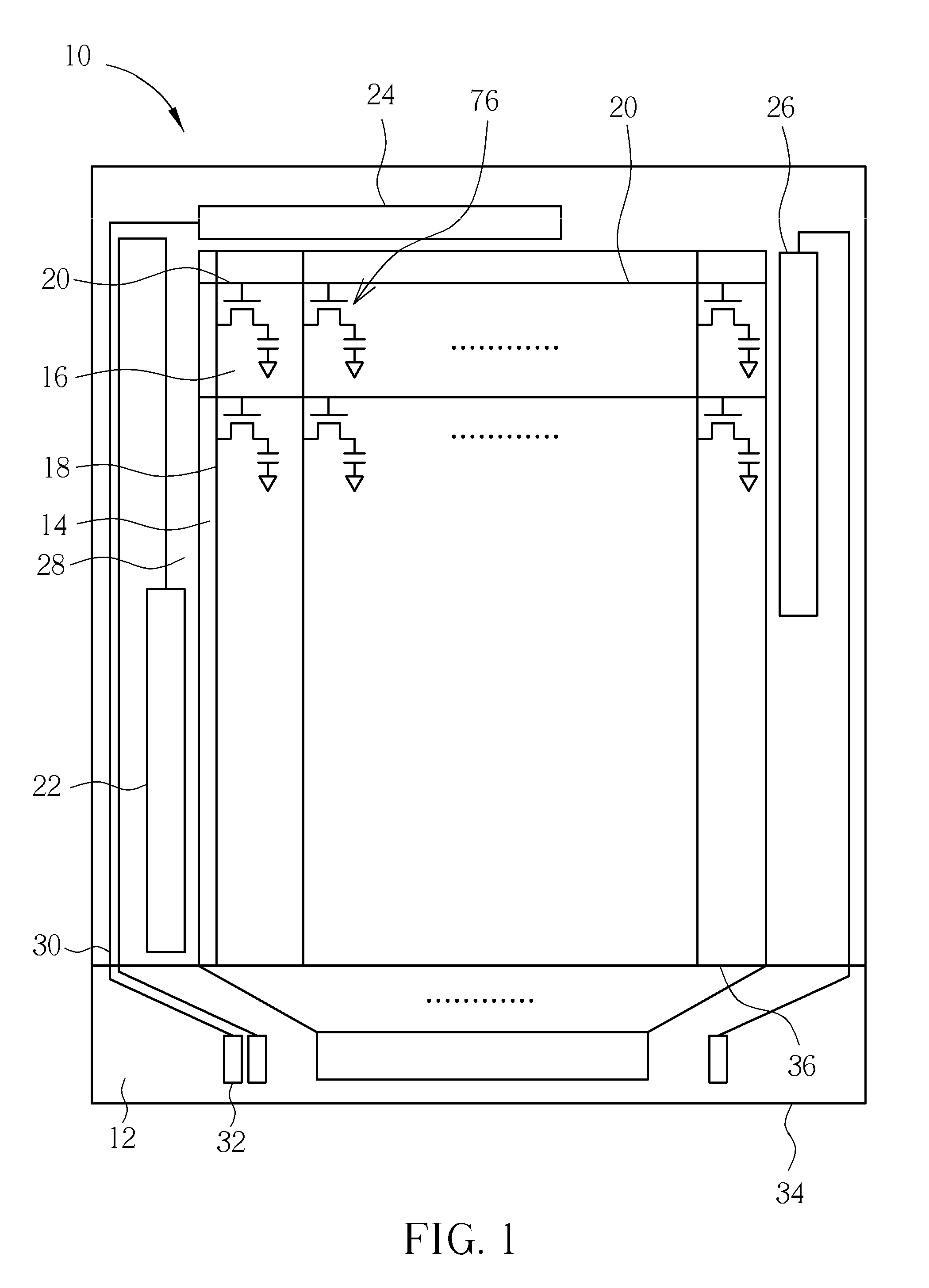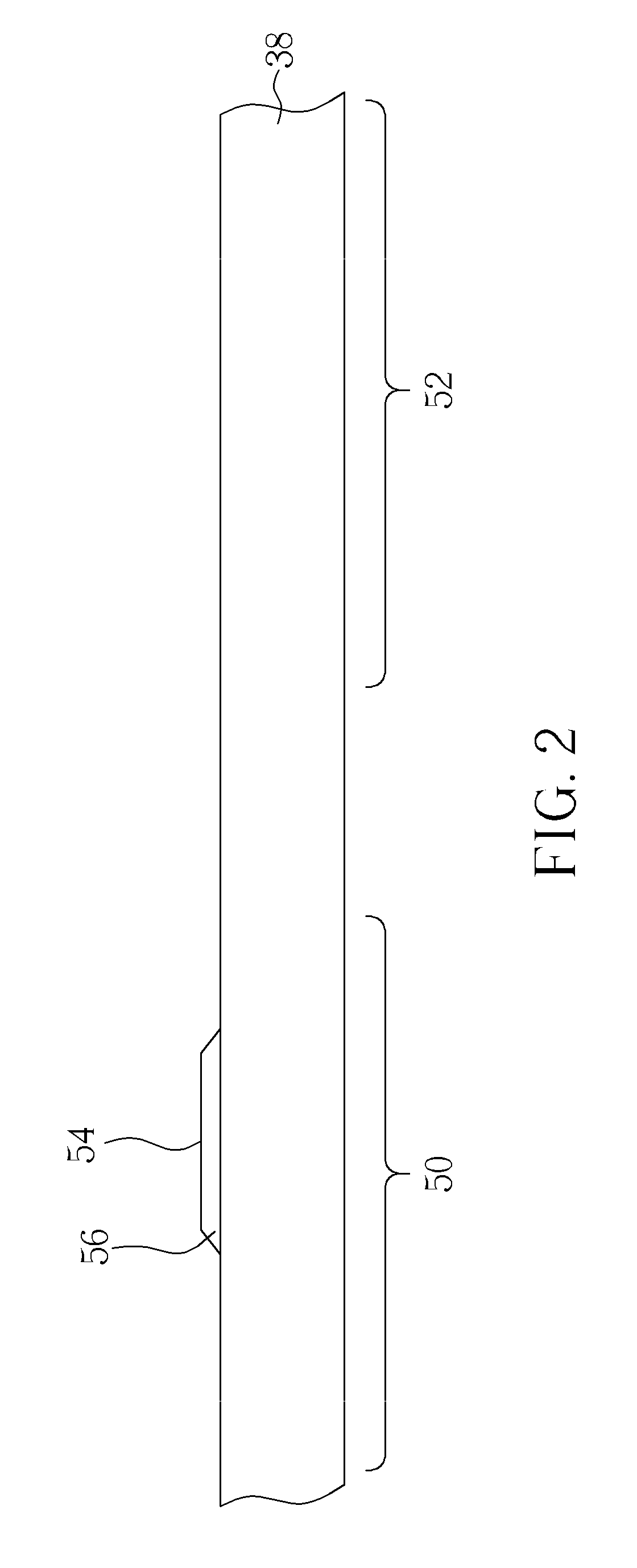Method for fabricating photo sensor
a technology of photosensors and manufacturing methods, applied in the direction of basic electric elements, electrical equipment, semiconductor devices, etc., can solve the problems of limiting the application and productivity of traditional pin photodiodes, poor signal-to-noise ratio, and low light receiving efficiency, so as to reduce the manufacturing cost of amorphous silicon tft display panels and improve product reliability
- Summary
- Abstract
- Description
- Claims
- Application Information
AI Technical Summary
Benefits of technology
Problems solved by technology
Method used
Image
Examples
first embodiment
[0020]FIGS. 2-7 illustrate cross-sectional views of a method for forming a photo sensor on an amorphous silicon TFT display panel according to the present invention. As shown in FIG. 2, a substrate 38 is provided. The substrate 38, which may be an array substrate of a flat display panel, includes at least a TFT region 50, and at least a sensor region 52. A first conductive layer is then entirely deposited on the substrate 38, and a first photolithographic and etching process using a first mask is performed to form a first patterned conductive layer 54. The first pattern conductive layer 54 is preferably metal material, and includes a gate electrode 56 disposed in the TFT region 50. As shown in FIG. 3, a gate insulating layer 58 is deposited on the substrate 38 and the gate electrode 56, and an amorphous silicon layer and a doped amorphous silicon layer are consecutively formed on the gate insulating layer 58. A second photolithographic and etching process using a second mask is perf...
third embodiment
[0026]FIGS. 9-10 illustrate a method of forming a photo sensor according to the present invention, where FIG. 9 follows FIG. 3. As shown in FIG. 9, after forming the patterned amorphous silicon layer 60 and the doped amorphous silicon layer 62, a second patterned conductive layer 64′ including a source electrode 70, a drain electrode 72 and a bottom electrode 74 is formed on the substrate 38. The second patterned conductive layer 64′ may be formed by the following steps. First, a second conductive layer (as the second conductive layer 64 shown in FIG. 4) and a photoresist layer (not shown) are entirely deposited on the substrate 38. Then, a photolithographic and etching process is performed to partially remove the second conductive layer 64 and the doped amorphous silicon layer 62. Subsequently, a patterned passivation layer 78 including a through hole 80 partially exposing the drain electrode 72 and a through hole 92 exposing most of the bottom electrode 74 is formed on the substra...
fourth embodiment
[0028]In other embodiments of the present invention, the silicon-rich dielectric layer 66 is formed in the TFT region 50 as well as in the sensor region 52. FIG. 11 illustrates a method for forming a photo sensor according to the present invention, where FIG. 11 follows the fabrication of FIG. 9. As shown in FIG. 11, after forming the TFT 76 and the passivation layer 78, a patterned silicon-rich dielectric layer 66 is formed on the substrate 38. The silicon-rich dielectric layer 66 includes a first part 66a disposed in the sensor region 52, and a second part 66b disposed in the TFT region 50, where the first part 66a is used as the photosensitive material of the photo sensor 88, and the second part 66b is used as another passivation layer of the TFT 76, the source electrode 70 and the drain electrode 72. The patterned silicon-rich dielectric layer 66 may be formed by the following steps. First, a silicon-rich dielectric layer 66 is entirely deposited on the substrate 38. Then, a pho...
PUM
| Property | Measurement | Unit |
|---|---|---|
| conductive | aaaaa | aaaaa |
| transparent conductive | aaaaa | aaaaa |
| dielectric | aaaaa | aaaaa |
Abstract
Description
Claims
Application Information
 Login to View More
Login to View More - R&D
- Intellectual Property
- Life Sciences
- Materials
- Tech Scout
- Unparalleled Data Quality
- Higher Quality Content
- 60% Fewer Hallucinations
Browse by: Latest US Patents, China's latest patents, Technical Efficacy Thesaurus, Application Domain, Technology Topic, Popular Technical Reports.
© 2025 PatSnap. All rights reserved.Legal|Privacy policy|Modern Slavery Act Transparency Statement|Sitemap|About US| Contact US: help@patsnap.com



